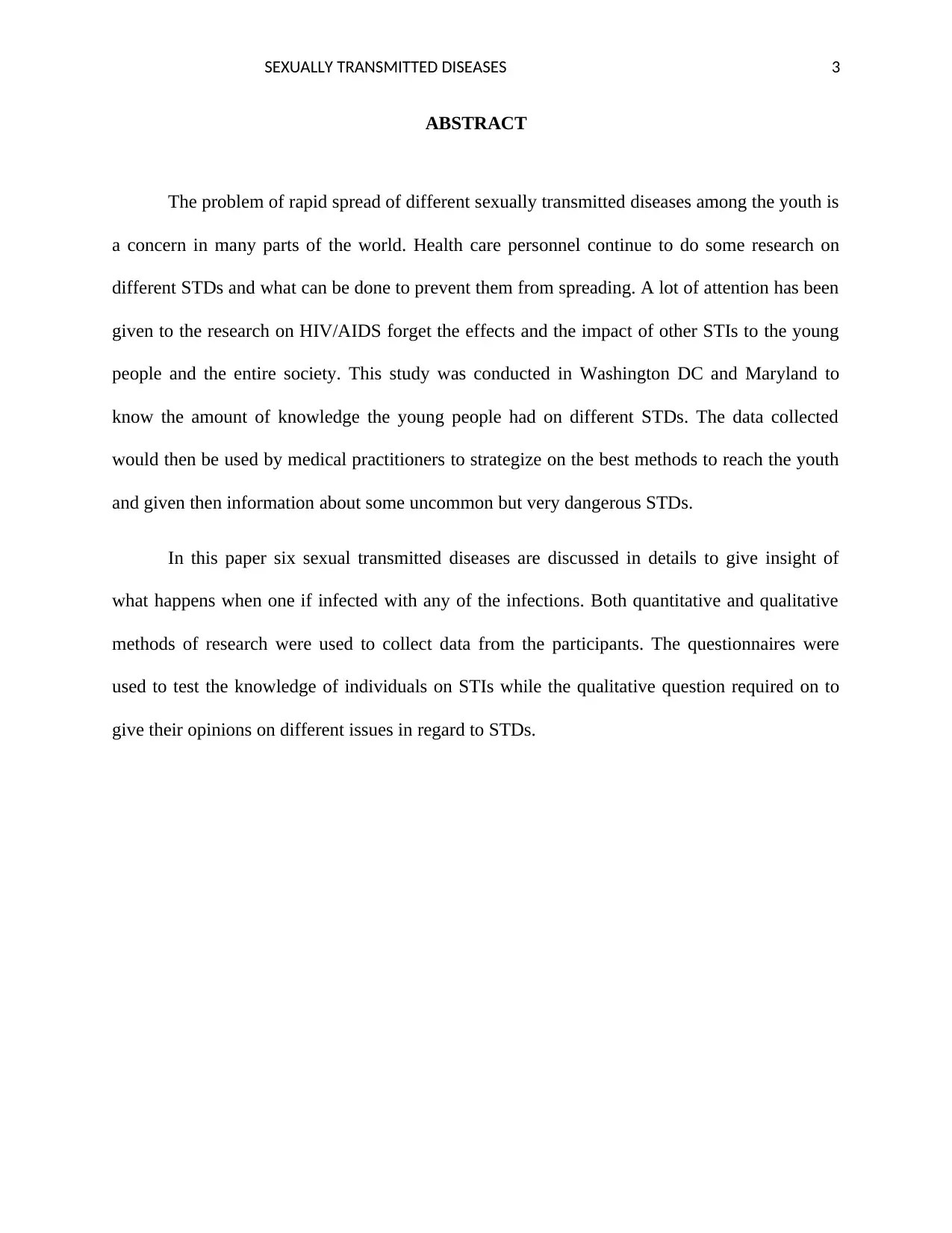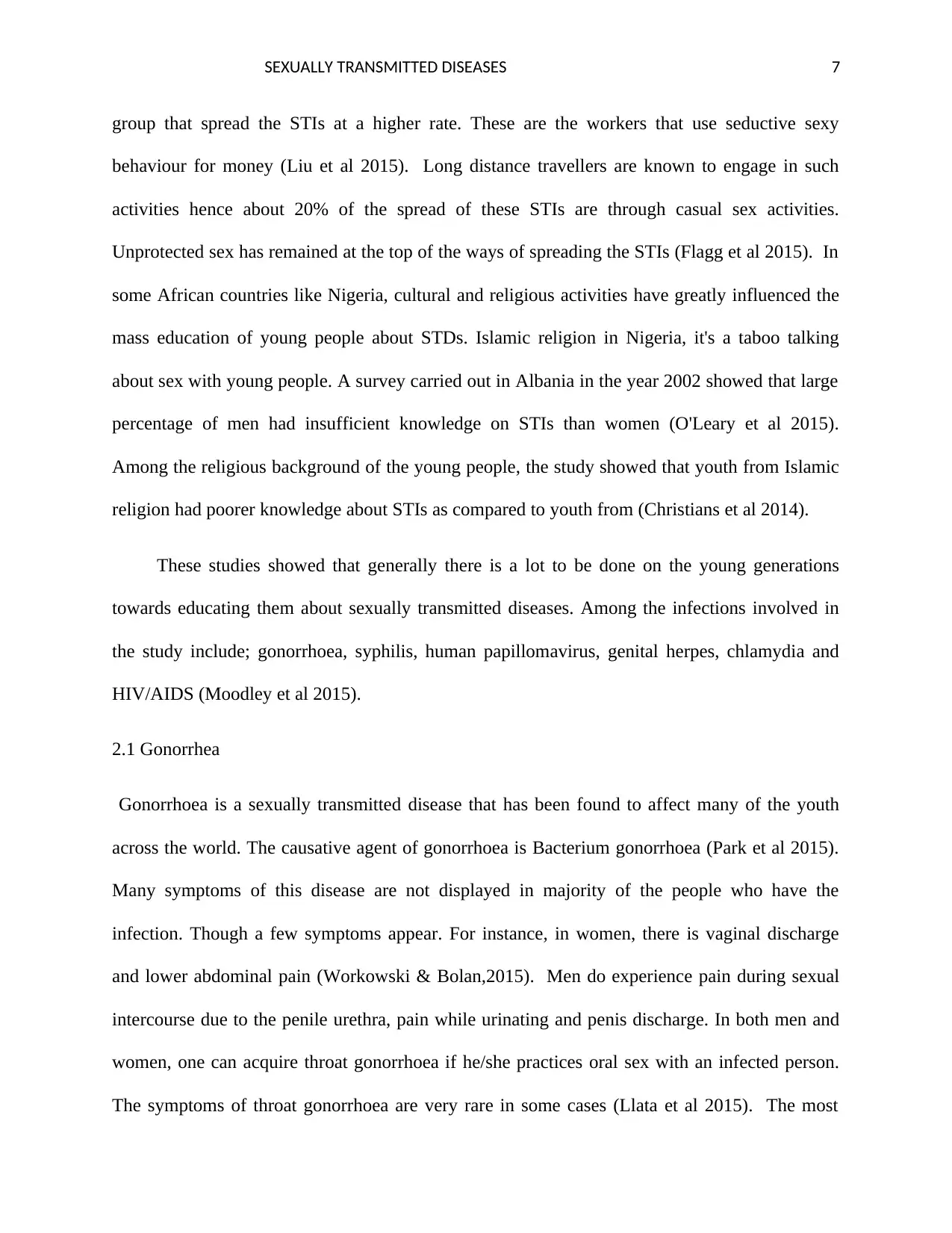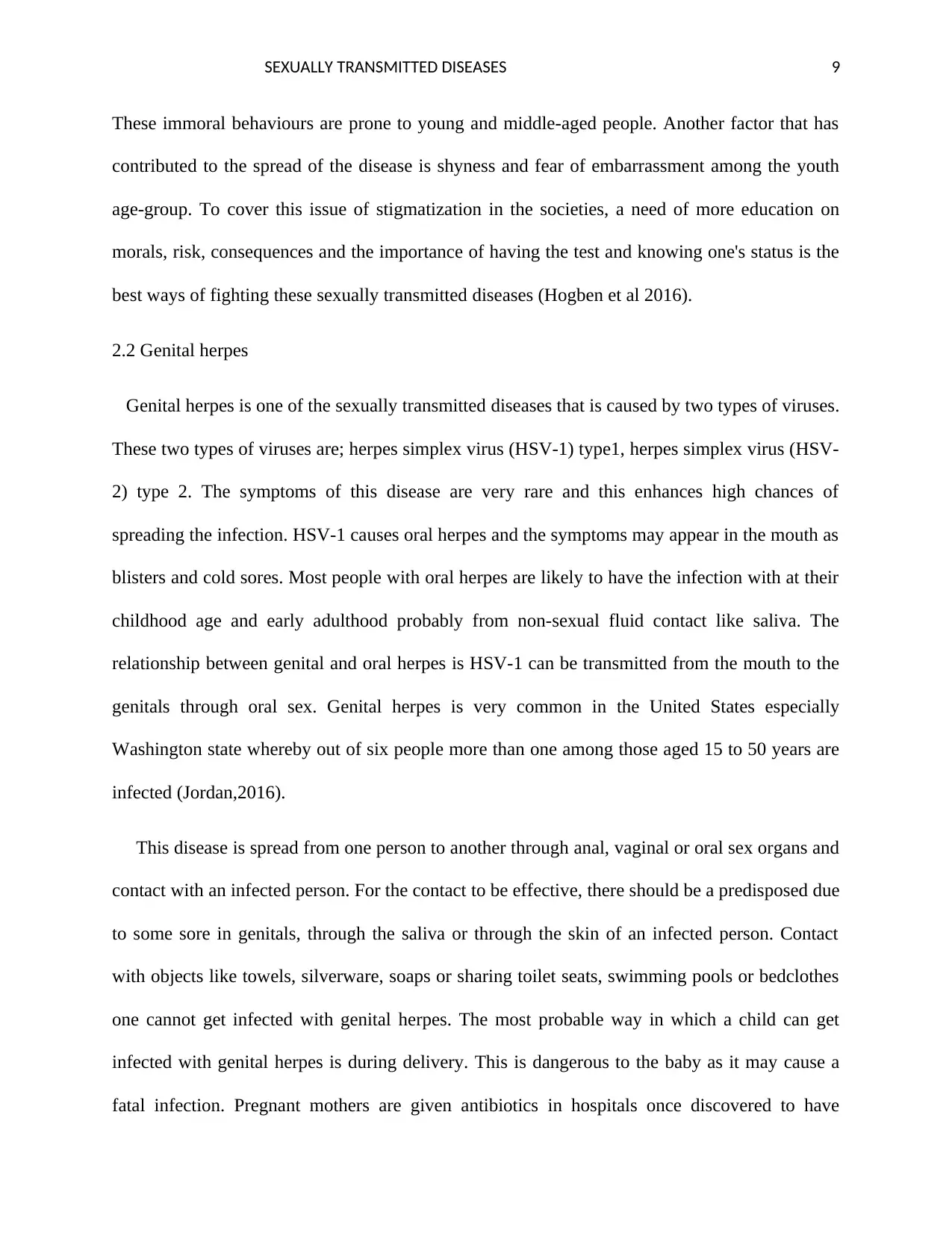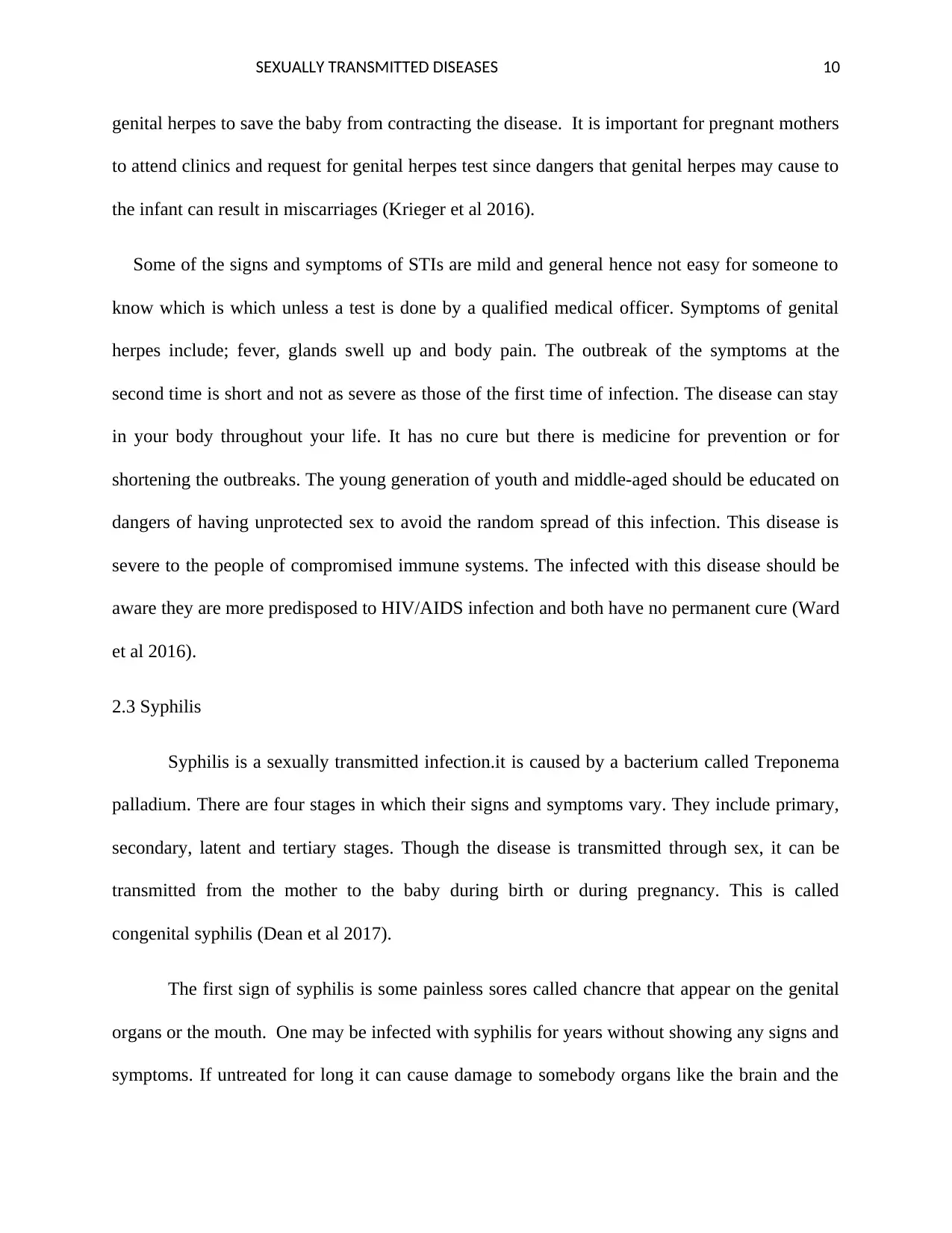Knowledge and Perception of STDs Among Young People Thesis
VerifiedAdded on 2021/04/21
|31
|8424
|248
Thesis and Dissertation
AI Summary
This thesis paper investigates the knowledge and perceptions of young people regarding sexually transmitted diseases (STDs). The study, conducted in Washington D.C. and Maryland, aims to assess the level of understanding among youth about various STDs, including Gonorrhea, Genital Herpes, Syphilis, HIV/AIDS, Chlamydia, and Human Papilloma Virus (HPV). The research employs both quantitative and qualitative methodologies, utilizing questionnaires to evaluate knowledge and open-ended questions to explore perceptions. The literature review covers the causes, symptoms, and prevalence of these STDs, emphasizing the importance of education and awareness to combat their spread. The paper also discusses the methodology, results, and implications of the study, highlighting the need for targeted interventions to improve young people's understanding and attitudes towards STDs. The findings will be used by medical practitioners to strategize on the best methods to reach the youth and give them information about some uncommon but very dangerous STDs.

Running head: SEXUALLY TRANSMITTED DISEASES 1
Thesis paper
Knowledge and perception of young people about sexual transmitted diseases
Student’s Name
Professor’s Name
Institute of Affiliation
Date
Thesis paper
Knowledge and perception of young people about sexual transmitted diseases
Student’s Name
Professor’s Name
Institute of Affiliation
Date
Paraphrase This Document
Need a fresh take? Get an instant paraphrase of this document with our AI Paraphraser

SEXUALLY TRANSMITTED DISEASES 2
Table of Contents
ABSTRACT....................................................................................................................................3
INTRODUCTION...........................................................................................................................4
LITERATURE REVIEW................................................................................................................6
2.1 Gonorrhea...............................................................................................................................8
2.2 Genital herpes........................................................................................................................9
2.3 Syphilis.................................................................................................................................10
2.4 HIV/AIDS............................................................................................................................12
2.5 Chlamydia............................................................................................................................14
2.6 Human papilloma virus........................................................................................................15
The aim and objective of the study............................................................................................16
Thesis questions.........................................................................................................................16
METHODOLOGY........................................................................................................................17
RESULTS......................................................................................................................................19
DISCUSSION................................................................................................................................20
STRENGTHS AND LIMITATIONS............................................................................................21
References......................................................................................................................................23
Appendix........................................................................................................................................29
Table of Contents
ABSTRACT....................................................................................................................................3
INTRODUCTION...........................................................................................................................4
LITERATURE REVIEW................................................................................................................6
2.1 Gonorrhea...............................................................................................................................8
2.2 Genital herpes........................................................................................................................9
2.3 Syphilis.................................................................................................................................10
2.4 HIV/AIDS............................................................................................................................12
2.5 Chlamydia............................................................................................................................14
2.6 Human papilloma virus........................................................................................................15
The aim and objective of the study............................................................................................16
Thesis questions.........................................................................................................................16
METHODOLOGY........................................................................................................................17
RESULTS......................................................................................................................................19
DISCUSSION................................................................................................................................20
STRENGTHS AND LIMITATIONS............................................................................................21
References......................................................................................................................................23
Appendix........................................................................................................................................29

SEXUALLY TRANSMITTED DISEASES 3
ABSTRACT
The problem of rapid spread of different sexually transmitted diseases among the youth is
a concern in many parts of the world. Health care personnel continue to do some research on
different STDs and what can be done to prevent them from spreading. A lot of attention has been
given to the research on HIV/AIDS forget the effects and the impact of other STIs to the young
people and the entire society. This study was conducted in Washington DC and Maryland to
know the amount of knowledge the young people had on different STDs. The data collected
would then be used by medical practitioners to strategize on the best methods to reach the youth
and given then information about some uncommon but very dangerous STDs.
In this paper six sexual transmitted diseases are discussed in details to give insight of
what happens when one if infected with any of the infections. Both quantitative and qualitative
methods of research were used to collect data from the participants. The questionnaires were
used to test the knowledge of individuals on STIs while the qualitative question required on to
give their opinions on different issues in regard to STDs.
ABSTRACT
The problem of rapid spread of different sexually transmitted diseases among the youth is
a concern in many parts of the world. Health care personnel continue to do some research on
different STDs and what can be done to prevent them from spreading. A lot of attention has been
given to the research on HIV/AIDS forget the effects and the impact of other STIs to the young
people and the entire society. This study was conducted in Washington DC and Maryland to
know the amount of knowledge the young people had on different STDs. The data collected
would then be used by medical practitioners to strategize on the best methods to reach the youth
and given then information about some uncommon but very dangerous STDs.
In this paper six sexual transmitted diseases are discussed in details to give insight of
what happens when one if infected with any of the infections. Both quantitative and qualitative
methods of research were used to collect data from the participants. The questionnaires were
used to test the knowledge of individuals on STIs while the qualitative question required on to
give their opinions on different issues in regard to STDs.
⊘ This is a preview!⊘
Do you want full access?
Subscribe today to unlock all pages.

Trusted by 1+ million students worldwide

SEXUALLY TRANSMITTED DISEASES 4
INTRODUCTION
Sexually transmitted diseases can also be abbreviated as STDs or STIs. The diseases are
transmitted by viruses, protozoa and the bacteria. Sexual intercourse is the main cause of the
diseases in many cases. Other methods of transmission include the oral sex, few cases in body
organ transplant and unscreened blood transfusion. The venereal disease is another name that can
be used when referring sexually transmitted diseases (Chesson et al 2014).
Perception can be defined as something detected by the five senses of human or a state of
conscious understanding of something. Knowledge is an awareness of a specific factor a
condition. The knowledge can as well be defined as a state of having been informed or made
aware of something. The researcher was interested to know the cause of an increase of sexually
transmitted infections among the young generation (Jones et al 2014). The statics provided by
united nations and Aids showed that about one million young people transmit STDs in each and
every year,
By the end of research, the researcher expects to know why sexually transmitted diseases are
spread at the high rate, by investigating the knowledge and perception of young people in
relation to STDs.The information collected from this research can be used by social health
organization and public health in countering the diseases. The healthy educators can as well use
the information to create awareness to young people (Alexander et al 2018).
The data collection was done by filling of a short questionnaire in one of the clinics in
Washington DC and another in Maryland. Sexually transmitted diseases today are spreading at
the high rate because many people are getting more sexually agile especially among young
people (Carter et al 2014). The other cause is the practice of sex with more than one partner
INTRODUCTION
Sexually transmitted diseases can also be abbreviated as STDs or STIs. The diseases are
transmitted by viruses, protozoa and the bacteria. Sexual intercourse is the main cause of the
diseases in many cases. Other methods of transmission include the oral sex, few cases in body
organ transplant and unscreened blood transfusion. The venereal disease is another name that can
be used when referring sexually transmitted diseases (Chesson et al 2014).
Perception can be defined as something detected by the five senses of human or a state of
conscious understanding of something. Knowledge is an awareness of a specific factor a
condition. The knowledge can as well be defined as a state of having been informed or made
aware of something. The researcher was interested to know the cause of an increase of sexually
transmitted infections among the young generation (Jones et al 2014). The statics provided by
united nations and Aids showed that about one million young people transmit STDs in each and
every year,
By the end of research, the researcher expects to know why sexually transmitted diseases are
spread at the high rate, by investigating the knowledge and perception of young people in
relation to STDs.The information collected from this research can be used by social health
organization and public health in countering the diseases. The healthy educators can as well use
the information to create awareness to young people (Alexander et al 2018).
The data collection was done by filling of a short questionnaire in one of the clinics in
Washington DC and another in Maryland. Sexually transmitted diseases today are spreading at
the high rate because many people are getting more sexually agile especially among young
people (Carter et al 2014). The other cause is the practice of sex with more than one partner
Paraphrase This Document
Need a fresh take? Get an instant paraphrase of this document with our AI Paraphraser

SEXUALLY TRANSMITTED DISEASES 5
among the married people. In the quantitative methodology, patients in one of the in clinics were
given a questionnaire with 10 simple question to test their knowledge on STIs. In qualitative
methodology, the same patients were to answer a single simple question inform of an essay on
their perception and attitudes towards STIs (Drainoni et al 2014).
among the married people. In the quantitative methodology, patients in one of the in clinics were
given a questionnaire with 10 simple question to test their knowledge on STIs. In qualitative
methodology, the same patients were to answer a single simple question inform of an essay on
their perception and attitudes towards STIs (Drainoni et al 2014).

SEXUALLY TRANSMITTED DISEASES 6
LITERATURE REVIEW
Sexually transmitted diseases are one of the major problems that have affected many
youths globally. This has been contributed to by the insufficient knowledge the young people
have about the STDs. Young adults have a common ignorance and disbelieve about the dangers
and consequences of sexually transmitted infections (Llata et al 2014). The problem comes
because these sexually transmitted infections (STIs) have comparable symptoms and that makes
them difficult to notice (Muzny et al 2014). The signs and symptoms rarely do appear to an
infected person, so it is easy to spread the disease without knowing if one is infected with the
disease. Another factor that has contributed to the spread of the diseases is the insufficient
medical institutions that offer the STIs tests. Private medical institutions are expensive and this
limits youth's interest for tests. Adequate understanding of STIs to the youths is still low in both
developing and developed countries. All other STIs create a high prevalence of contracting
HIV/AID, because of their predisposed sex organs due to damage caused by other sexually
transmitted diseases. All STIs are transmitted through either virginal, anal or oral sex. About
60% to 80% of youth who have knowledge of HIV/AIDS have inadequate knowledge about
other sexually transmitted diseases (Oster et al 2014).
According to recent reports Centers for Disease Control and Prevention. (2015) the
survey, about 20 million STDs occur in the United States. More than 498 million cases of STDs
occur worldwide every year. The involved population that shown better understanding of STIs
said they have acquired knowledge about STIs through media, internet, television, brochures and
education through public awareness. Casual sex workers have been known to be the most rated
LITERATURE REVIEW
Sexually transmitted diseases are one of the major problems that have affected many
youths globally. This has been contributed to by the insufficient knowledge the young people
have about the STDs. Young adults have a common ignorance and disbelieve about the dangers
and consequences of sexually transmitted infections (Llata et al 2014). The problem comes
because these sexually transmitted infections (STIs) have comparable symptoms and that makes
them difficult to notice (Muzny et al 2014). The signs and symptoms rarely do appear to an
infected person, so it is easy to spread the disease without knowing if one is infected with the
disease. Another factor that has contributed to the spread of the diseases is the insufficient
medical institutions that offer the STIs tests. Private medical institutions are expensive and this
limits youth's interest for tests. Adequate understanding of STIs to the youths is still low in both
developing and developed countries. All other STIs create a high prevalence of contracting
HIV/AID, because of their predisposed sex organs due to damage caused by other sexually
transmitted diseases. All STIs are transmitted through either virginal, anal or oral sex. About
60% to 80% of youth who have knowledge of HIV/AIDS have inadequate knowledge about
other sexually transmitted diseases (Oster et al 2014).
According to recent reports Centers for Disease Control and Prevention. (2015) the
survey, about 20 million STDs occur in the United States. More than 498 million cases of STDs
occur worldwide every year. The involved population that shown better understanding of STIs
said they have acquired knowledge about STIs through media, internet, television, brochures and
education through public awareness. Casual sex workers have been known to be the most rated
⊘ This is a preview!⊘
Do you want full access?
Subscribe today to unlock all pages.

Trusted by 1+ million students worldwide

SEXUALLY TRANSMITTED DISEASES 7
group that spread the STIs at a higher rate. These are the workers that use seductive sexy
behaviour for money (Liu et al 2015). Long distance travellers are known to engage in such
activities hence about 20% of the spread of these STIs are through casual sex activities.
Unprotected sex has remained at the top of the ways of spreading the STIs (Flagg et al 2015). In
some African countries like Nigeria, cultural and religious activities have greatly influenced the
mass education of young people about STDs. Islamic religion in Nigeria, it's a taboo talking
about sex with young people. A survey carried out in Albania in the year 2002 showed that large
percentage of men had insufficient knowledge on STIs than women (O'Leary et al 2015).
Among the religious background of the young people, the study showed that youth from Islamic
religion had poorer knowledge about STIs as compared to youth from (Christians et al 2014).
These studies showed that generally there is a lot to be done on the young generations
towards educating them about sexually transmitted diseases. Among the infections involved in
the study include; gonorrhoea, syphilis, human papillomavirus, genital herpes, chlamydia and
HIV/AIDS (Moodley et al 2015).
2.1 Gonorrhea
Gonorrhoea is a sexually transmitted disease that has been found to affect many of the youth
across the world. The causative agent of gonorrhoea is Bacterium gonorrhoea (Park et al 2015).
Many symptoms of this disease are not displayed in majority of the people who have the
infection. Though a few symptoms appear. For instance, in women, there is vaginal discharge
and lower abdominal pain (Workowski & Bolan,2015). Men do experience pain during sexual
intercourse due to the penile urethra, pain while urinating and penis discharge. In both men and
women, one can acquire throat gonorrhoea if he/she practices oral sex with an infected person.
The symptoms of throat gonorrhoea are very rare in some cases (Llata et al 2015). The most
group that spread the STIs at a higher rate. These are the workers that use seductive sexy
behaviour for money (Liu et al 2015). Long distance travellers are known to engage in such
activities hence about 20% of the spread of these STIs are through casual sex activities.
Unprotected sex has remained at the top of the ways of spreading the STIs (Flagg et al 2015). In
some African countries like Nigeria, cultural and religious activities have greatly influenced the
mass education of young people about STDs. Islamic religion in Nigeria, it's a taboo talking
about sex with young people. A survey carried out in Albania in the year 2002 showed that large
percentage of men had insufficient knowledge on STIs than women (O'Leary et al 2015).
Among the religious background of the young people, the study showed that youth from Islamic
religion had poorer knowledge about STIs as compared to youth from (Christians et al 2014).
These studies showed that generally there is a lot to be done on the young generations
towards educating them about sexually transmitted diseases. Among the infections involved in
the study include; gonorrhoea, syphilis, human papillomavirus, genital herpes, chlamydia and
HIV/AIDS (Moodley et al 2015).
2.1 Gonorrhea
Gonorrhoea is a sexually transmitted disease that has been found to affect many of the youth
across the world. The causative agent of gonorrhoea is Bacterium gonorrhoea (Park et al 2015).
Many symptoms of this disease are not displayed in majority of the people who have the
infection. Though a few symptoms appear. For instance, in women, there is vaginal discharge
and lower abdominal pain (Workowski & Bolan,2015). Men do experience pain during sexual
intercourse due to the penile urethra, pain while urinating and penis discharge. In both men and
women, one can acquire throat gonorrhoea if he/she practices oral sex with an infected person.
The symptoms of throat gonorrhoea are very rare in some cases (Llata et al 2015). The most
Paraphrase This Document
Need a fresh take? Get an instant paraphrase of this document with our AI Paraphraser

SEXUALLY TRANSMITTED DISEASES 8
common symptom that may appear is a sore in the throat. About 90% of the infected people do
not show symptoms. Tiredness and bacterial allergic reaction are among the advanced symptoms
of gonorrhoea. The incubation period of gonorrhoea is 2 to 14 days and most symptoms are
experienced between 4 and 6 days from the day of infection. These symptoms may appear on the
skin as lesions, pain and swelling of joints as the disease travels through the bloodstream. This
disease can go deeper and if not treated early may develop to prostate cancer. There is re-
infection whereby somebody who is infected comes into sexual contact with another infected
person. Due to lack of outer or displayed symptoms, an infected person may infect others
repeatedly without his/her knowledge. The percentage risk of a man getting infected after having
sex with an infected woman is 20% while that of a woman getting infected after having sex with
the infected man is 60% to 80%. This percentage is prone to the young people (Bollerup et al
2016).
The diagnosis of this disease should be taken from samples of vaginal discharge, urine or
urethral fluids for screening and testing of the infection. The polymerase chain reaction (PCR) is
used to identify the specific gene of species Neisseria gonorrhoea. People who test positive for
gonorrhoea are most likely to contract other sexually transmitted diseases (STSs) such as
chlamydia syphilis and human papillomavirus (Davey et al 2016). Recent researchers have
shown that 46% to 50% of young people who have chlamydia are likely to have gonorrhoea. The
risk of contracting gonorrhoea has a high preference for women of 25 years and below. Men who
have sex with other men have high chances of contracting gonorrhoea. Many youths have the
ignorance of using condoms during sexual intercourse and this has contributed to the high rate of
the spread of the disease. Many of these young men and women include those who have sex for
money and those who have sex under influence of drugs like alcohol (Friedman et al 2016).
common symptom that may appear is a sore in the throat. About 90% of the infected people do
not show symptoms. Tiredness and bacterial allergic reaction are among the advanced symptoms
of gonorrhoea. The incubation period of gonorrhoea is 2 to 14 days and most symptoms are
experienced between 4 and 6 days from the day of infection. These symptoms may appear on the
skin as lesions, pain and swelling of joints as the disease travels through the bloodstream. This
disease can go deeper and if not treated early may develop to prostate cancer. There is re-
infection whereby somebody who is infected comes into sexual contact with another infected
person. Due to lack of outer or displayed symptoms, an infected person may infect others
repeatedly without his/her knowledge. The percentage risk of a man getting infected after having
sex with an infected woman is 20% while that of a woman getting infected after having sex with
the infected man is 60% to 80%. This percentage is prone to the young people (Bollerup et al
2016).
The diagnosis of this disease should be taken from samples of vaginal discharge, urine or
urethral fluids for screening and testing of the infection. The polymerase chain reaction (PCR) is
used to identify the specific gene of species Neisseria gonorrhoea. People who test positive for
gonorrhoea are most likely to contract other sexually transmitted diseases (STSs) such as
chlamydia syphilis and human papillomavirus (Davey et al 2016). Recent researchers have
shown that 46% to 50% of young people who have chlamydia are likely to have gonorrhoea. The
risk of contracting gonorrhoea has a high preference for women of 25 years and below. Men who
have sex with other men have high chances of contracting gonorrhoea. Many youths have the
ignorance of using condoms during sexual intercourse and this has contributed to the high rate of
the spread of the disease. Many of these young men and women include those who have sex for
money and those who have sex under influence of drugs like alcohol (Friedman et al 2016).

SEXUALLY TRANSMITTED DISEASES 9
These immoral behaviours are prone to young and middle-aged people. Another factor that has
contributed to the spread of the disease is shyness and fear of embarrassment among the youth
age-group. To cover this issue of stigmatization in the societies, a need of more education on
morals, risk, consequences and the importance of having the test and knowing one's status is the
best ways of fighting these sexually transmitted diseases (Hogben et al 2016).
2.2 Genital herpes
Genital herpes is one of the sexually transmitted diseases that is caused by two types of viruses.
These two types of viruses are; herpes simplex virus (HSV-1) type1, herpes simplex virus (HSV-
2) type 2. The symptoms of this disease are very rare and this enhances high chances of
spreading the infection. HSV-1 causes oral herpes and the symptoms may appear in the mouth as
blisters and cold sores. Most people with oral herpes are likely to have the infection with at their
childhood age and early adulthood probably from non-sexual fluid contact like saliva. The
relationship between genital and oral herpes is HSV-1 can be transmitted from the mouth to the
genitals through oral sex. Genital herpes is very common in the United States especially
Washington state whereby out of six people more than one among those aged 15 to 50 years are
infected (Jordan,2016).
This disease is spread from one person to another through anal, vaginal or oral sex organs and
contact with an infected person. For the contact to be effective, there should be a predisposed due
to some sore in genitals, through the saliva or through the skin of an infected person. Contact
with objects like towels, silverware, soaps or sharing toilet seats, swimming pools or bedclothes
one cannot get infected with genital herpes. The most probable way in which a child can get
infected with genital herpes is during delivery. This is dangerous to the baby as it may cause a
fatal infection. Pregnant mothers are given antibiotics in hospitals once discovered to have
These immoral behaviours are prone to young and middle-aged people. Another factor that has
contributed to the spread of the disease is shyness and fear of embarrassment among the youth
age-group. To cover this issue of stigmatization in the societies, a need of more education on
morals, risk, consequences and the importance of having the test and knowing one's status is the
best ways of fighting these sexually transmitted diseases (Hogben et al 2016).
2.2 Genital herpes
Genital herpes is one of the sexually transmitted diseases that is caused by two types of viruses.
These two types of viruses are; herpes simplex virus (HSV-1) type1, herpes simplex virus (HSV-
2) type 2. The symptoms of this disease are very rare and this enhances high chances of
spreading the infection. HSV-1 causes oral herpes and the symptoms may appear in the mouth as
blisters and cold sores. Most people with oral herpes are likely to have the infection with at their
childhood age and early adulthood probably from non-sexual fluid contact like saliva. The
relationship between genital and oral herpes is HSV-1 can be transmitted from the mouth to the
genitals through oral sex. Genital herpes is very common in the United States especially
Washington state whereby out of six people more than one among those aged 15 to 50 years are
infected (Jordan,2016).
This disease is spread from one person to another through anal, vaginal or oral sex organs and
contact with an infected person. For the contact to be effective, there should be a predisposed due
to some sore in genitals, through the saliva or through the skin of an infected person. Contact
with objects like towels, silverware, soaps or sharing toilet seats, swimming pools or bedclothes
one cannot get infected with genital herpes. The most probable way in which a child can get
infected with genital herpes is during delivery. This is dangerous to the baby as it may cause a
fatal infection. Pregnant mothers are given antibiotics in hospitals once discovered to have
⊘ This is a preview!⊘
Do you want full access?
Subscribe today to unlock all pages.

Trusted by 1+ million students worldwide

SEXUALLY TRANSMITTED DISEASES 10
genital herpes to save the baby from contracting the disease. It is important for pregnant mothers
to attend clinics and request for genital herpes test since dangers that genital herpes may cause to
the infant can result in miscarriages (Krieger et al 2016).
Some of the signs and symptoms of STIs are mild and general hence not easy for someone to
know which is which unless a test is done by a qualified medical officer. Symptoms of genital
herpes include; fever, glands swell up and body pain. The outbreak of the symptoms at the
second time is short and not as severe as those of the first time of infection. The disease can stay
in your body throughout your life. It has no cure but there is medicine for prevention or for
shortening the outbreaks. The young generation of youth and middle-aged should be educated on
dangers of having unprotected sex to avoid the random spread of this infection. This disease is
severe to the people of compromised immune systems. The infected with this disease should be
aware they are more predisposed to HIV/AIDS infection and both have no permanent cure (Ward
et al 2016).
2.3 Syphilis
Syphilis is a sexually transmitted infection.it is caused by a bacterium called Treponema
palladium. There are four stages in which their signs and symptoms vary. They include primary,
secondary, latent and tertiary stages. Though the disease is transmitted through sex, it can be
transmitted from the mother to the baby during birth or during pregnancy. This is called
congenital syphilis (Dean et al 2017).
The first sign of syphilis is some painless sores called chancre that appear on the genital
organs or the mouth. One may be infected with syphilis for years without showing any signs and
symptoms. If untreated for long it can cause damage to somebody organs like the brain and the
genital herpes to save the baby from contracting the disease. It is important for pregnant mothers
to attend clinics and request for genital herpes test since dangers that genital herpes may cause to
the infant can result in miscarriages (Krieger et al 2016).
Some of the signs and symptoms of STIs are mild and general hence not easy for someone to
know which is which unless a test is done by a qualified medical officer. Symptoms of genital
herpes include; fever, glands swell up and body pain. The outbreak of the symptoms at the
second time is short and not as severe as those of the first time of infection. The disease can stay
in your body throughout your life. It has no cure but there is medicine for prevention or for
shortening the outbreaks. The young generation of youth and middle-aged should be educated on
dangers of having unprotected sex to avoid the random spread of this infection. This disease is
severe to the people of compromised immune systems. The infected with this disease should be
aware they are more predisposed to HIV/AIDS infection and both have no permanent cure (Ward
et al 2016).
2.3 Syphilis
Syphilis is a sexually transmitted infection.it is caused by a bacterium called Treponema
palladium. There are four stages in which their signs and symptoms vary. They include primary,
secondary, latent and tertiary stages. Though the disease is transmitted through sex, it can be
transmitted from the mother to the baby during birth or during pregnancy. This is called
congenital syphilis (Dean et al 2017).
The first sign of syphilis is some painless sores called chancre that appear on the genital
organs or the mouth. One may be infected with syphilis for years without showing any signs and
symptoms. If untreated for long it can cause damage to somebody organs like the brain and the
Paraphrase This Document
Need a fresh take? Get an instant paraphrase of this document with our AI Paraphraser

SEXUALLY TRANSMITTED DISEASES 11
heart.it is spread through direct contact with the syphilis chancres. The primary stage occurs 3-4
weeks after the infection. It begins with a small painless sore that appears where the syphilis
bacteria got into contact with the body e.g. rectum, genitals or the mouth.
During the second stage, sore throat and skin rashes may develop. The rashes are mostly found in
the soles of the feet and the palms of the hands but they may appear anywhere in the body. These
rashes normally don't itch. During the secondary stage, an individual may also experience
headaches, fatigue, fever, swollen lymph nodes, hair loss etc. As time goes on these symptoms
disappear with or without treatment though the disease still remains present in the body (Duncan
et al 2017).
Latent stage is the third stage of syphilis.it is also called the hidden stage. Both the
primary and secondary symptoms disappear and there are no more noticeable symptoms at this
stage though the bacteria is still in the body. Latent stage can last for months or even years
before the infection develops to the tertiary stage.
The last stage of syphilis infection is the tertiary stage.it occurs years after contracting the
infection. Tertiary syphilis can easily cause death, deafness, memory loss, blindness, heart
disease, mental illness and neurosyphilis which affects the brain or the spinal cord. In the year
2015, approximately 45.4 million people had syphilis infection around the globe. Six million of
these were the newly reported cases .in the same year syphilis caused an around of 107000
deaths.
A study conducted in china involving 3470 participants revealed that college students
were less aware of syphilis infection. The college students had very little knowledge of syphilis
compared to all other groups that took part in the study the study also revealed that the young
heart.it is spread through direct contact with the syphilis chancres. The primary stage occurs 3-4
weeks after the infection. It begins with a small painless sore that appears where the syphilis
bacteria got into contact with the body e.g. rectum, genitals or the mouth.
During the second stage, sore throat and skin rashes may develop. The rashes are mostly found in
the soles of the feet and the palms of the hands but they may appear anywhere in the body. These
rashes normally don't itch. During the secondary stage, an individual may also experience
headaches, fatigue, fever, swollen lymph nodes, hair loss etc. As time goes on these symptoms
disappear with or without treatment though the disease still remains present in the body (Duncan
et al 2017).
Latent stage is the third stage of syphilis.it is also called the hidden stage. Both the
primary and secondary symptoms disappear and there are no more noticeable symptoms at this
stage though the bacteria is still in the body. Latent stage can last for months or even years
before the infection develops to the tertiary stage.
The last stage of syphilis infection is the tertiary stage.it occurs years after contracting the
infection. Tertiary syphilis can easily cause death, deafness, memory loss, blindness, heart
disease, mental illness and neurosyphilis which affects the brain or the spinal cord. In the year
2015, approximately 45.4 million people had syphilis infection around the globe. Six million of
these were the newly reported cases .in the same year syphilis caused an around of 107000
deaths.
A study conducted in china involving 3470 participants revealed that college students
were less aware of syphilis infection. The college students had very little knowledge of syphilis
compared to all other groups that took part in the study the study also revealed that the young

SEXUALLY TRANSMITTED DISEASES 12
female participant with small levels of education had very little knowledge about syphilis. Lack
of knowledge of the infection has in a very great way influenced the rate at which the disease has
been spreading among the young people (Kreise et al 2017).
2.4 HIV/AIDS
HIV stands for human immunodeficiency virus. it causes AIDS which stands for acquired
immunodeficiency syndrome. The virus affects the immune system by destroying the white
blood cells which fight any infection that tries to get into the body. This makes people vulnerable
to diseases and infections. HIV attacks all the tissues in the body.it is found and transmitted
through the body fluids of an infected person. (Blood, virginal fluids, semen etc.) It can also be
transmitted from the mother to child through breastfeeding or during childbirth.
Some people who are infected with HIV do not show symptoms for some time until after
a couple of months or years. After the initial infection, the early symptoms of the HIV infection
may include joint pain, muscle aches, sore throat, chills fever, enlarged glands, general body
weakness, tiredness etc.in most cases these symptoms appear when the body is dealing with
different types of viruses and infections. After the disappearance of the initial symptoms, there
may not be any other symptoms for a number of years. At this time the virus continues to
increase and damage the body organ and the entire immune system (Pathela et al 2015). In case
HIV is left untreated, it destabilizes the ability of the body to fight infection. This is called the
stage 3 HIV or AIDS stage. The symptoms of this stage include persistent diarrhoea, blurred
vision, night sweats, dyspnea, and permanent tiredness, rapid weight loss, spots on the tongue or
mouth.
female participant with small levels of education had very little knowledge about syphilis. Lack
of knowledge of the infection has in a very great way influenced the rate at which the disease has
been spreading among the young people (Kreise et al 2017).
2.4 HIV/AIDS
HIV stands for human immunodeficiency virus. it causes AIDS which stands for acquired
immunodeficiency syndrome. The virus affects the immune system by destroying the white
blood cells which fight any infection that tries to get into the body. This makes people vulnerable
to diseases and infections. HIV attacks all the tissues in the body.it is found and transmitted
through the body fluids of an infected person. (Blood, virginal fluids, semen etc.) It can also be
transmitted from the mother to child through breastfeeding or during childbirth.
Some people who are infected with HIV do not show symptoms for some time until after
a couple of months or years. After the initial infection, the early symptoms of the HIV infection
may include joint pain, muscle aches, sore throat, chills fever, enlarged glands, general body
weakness, tiredness etc.in most cases these symptoms appear when the body is dealing with
different types of viruses and infections. After the disappearance of the initial symptoms, there
may not be any other symptoms for a number of years. At this time the virus continues to
increase and damage the body organ and the entire immune system (Pathela et al 2015). In case
HIV is left untreated, it destabilizes the ability of the body to fight infection. This is called the
stage 3 HIV or AIDS stage. The symptoms of this stage include persistent diarrhoea, blurred
vision, night sweats, dyspnea, and permanent tiredness, rapid weight loss, spots on the tongue or
mouth.
⊘ This is a preview!⊘
Do you want full access?
Subscribe today to unlock all pages.

Trusted by 1+ million students worldwide
1 out of 31
Related Documents
Your All-in-One AI-Powered Toolkit for Academic Success.
+13062052269
info@desklib.com
Available 24*7 on WhatsApp / Email
![[object Object]](/_next/static/media/star-bottom.7253800d.svg)
Unlock your academic potential
Copyright © 2020–2025 A2Z Services. All Rights Reserved. Developed and managed by ZUCOL.





